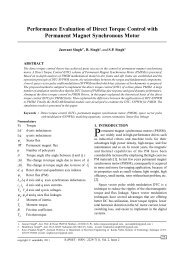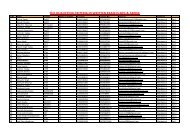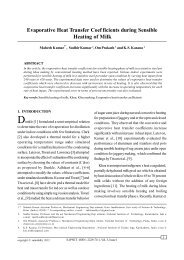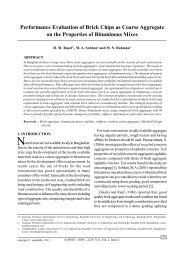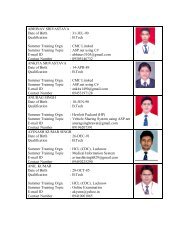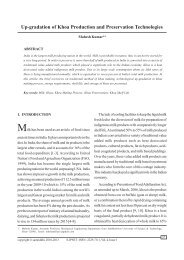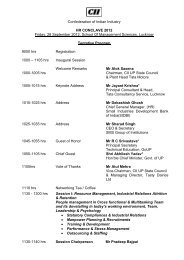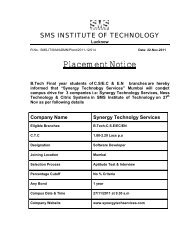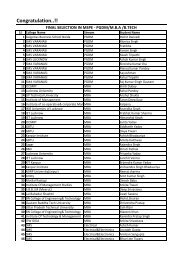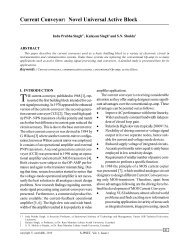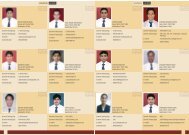Electronics Spectra - SMS Lucknow
Electronics Spectra - SMS Lucknow
Electronics Spectra - SMS Lucknow
You also want an ePaper? Increase the reach of your titles
YUMPU automatically turns print PDFs into web optimized ePapers that Google loves.
<strong>SMS</strong> Institute of Technology, L ucknow<br />
Department of <strong>Electronics</strong> & Co mmunication<br />
raises significant software issues: specifying<br />
functionality, managing<br />
concurrency, handling failure robustly,<br />
dealing with uncertain informa tion,<br />
and controlling resource usage. The<br />
software used to control clayt ronics<br />
must also scale to millions of catoms.<br />
Thus, current software enginee ring<br />
practices, even as applied to distributed<br />
systems, may not be suita ble.<br />
We are just beginning to explore the<br />
software design principles needed.<br />
I have broken down the software<br />
issues into three main categor ies:<br />
specification, compilation, and runtime<br />
support.<br />
Our goal is to specify the glo bal<br />
behavior of the system in a direct and<br />
descriptive manner. The simple st<br />
model we are investigating with respect<br />
to specification is what we call<br />
the Wood Sculpting model. In t his<br />
model, a static goal shape is specified.<br />
We are investigating two alternative<br />
compilation methodologies, bot h of<br />
which fit into the general category of<br />
single-program-multiple data (SPMD)<br />
programming models. In the first, we<br />
are compiling the specification into a<br />
planning problem. In this approach we<br />
are inspired by work done in communicating<br />
soccer robots and in the context<br />
of reconfigurable robots, by the<br />
constraint-based control framework in<br />
The wimax technology<br />
Wimax is a telecommunication<br />
technology that provide data over long<br />
distances to full mobile cellu lar type<br />
access. The word "wimax" means<br />
Worldwide Interoperability for Microwave<br />
Access. It is based on the wireless<br />
MAN (IEEE 802.16) standar d.<br />
Wimax is a highly scalable, long-range<br />
system, covering many km using licensed<br />
spectrum to connect internet<br />
from an ISP to an end user.<br />
The speed of Wimax devices are<br />
10 mb/s at 10 km distance. There is<br />
no uniform global licensed spe ctrum<br />
for wimax although three licen sed<br />
spectrum profiles are being used generally<br />
- 2.3 GHz, 2.5 GHz and 3.5 GHz.<br />
Wimax Wireless Network<br />
Wimax system have to parts :<br />
Wimax Tower : A Wimax tower<br />
can provide coverage to a very large<br />
area as 3000 m2 (8000 km2).<br />
Wimax Receiver : The receiver<br />
and antenna could be a small box are<br />
PCMCIA card or they could be b uilt<br />
into a laptop the way wifi acc ess is<br />
which a high-level description such as<br />
a particular gait which is translated to<br />
a distributed, constraint-base d controller.<br />
Our second approach is based<br />
on emergent behavior. Prior work by<br />
seems particularly appropriate in this<br />
latter approach with respect t o<br />
claytronics.<br />
At the highest level of abstraction<br />
a shape is specified in terms of Origami<br />
folding directives. Through a process<br />
of planning, these folding dir ectives<br />
are translated into low-level programs<br />
for autonomous agents; achieving the<br />
shape by local communication a nd<br />
deformation only.<br />
Underlying the user-level software<br />
is a distributed runtime system. This<br />
system needs to shield the user from<br />
the details of using and managing the<br />
massive number of catoms. Our initial<br />
steps in this direction use em ergent<br />
behavior to determine a catoms location<br />
and orientation with resp ect to<br />
all catoms as well as to build a hierarchical<br />
network for communicati on<br />
between catoms. Efficient localization<br />
is achieved by having the catoms determine<br />
their relative location and orientation<br />
in a distributed fashion. Then<br />
as regions of localized catoms join up<br />
they unify their coordinate sy stems.<br />
Once catoms are localized we form a<br />
hierarchical communication network,<br />
today.<br />
The Wimax can provide wireless<br />
services in two forms :<br />
‣ The Wimax uses a lower frequency<br />
range - 2 GHz to 11 GHz<br />
similar as wifi. Lower wave length<br />
transmissions are not as easily disrupted<br />
by physical obstructions -<br />
they are better able to diffract or<br />
bend, around obstacles.<br />
‣ There is line - of - sight service,<br />
where a fix dish antenna point s<br />
straight at the Wimax tower from<br />
a pole. The connection is stro n-<br />
ger and more stable, so its ab le<br />
to send a lot of data with fewer<br />
errors.<br />
Coverage and speed<br />
Wimax operates on the same general<br />
principle as wifi. It sends data from<br />
one computer to another using radio<br />
signals. The wimax connection can<br />
transmit upto 70 mb/second.<br />
The range of Wimax is 50 km radius.<br />
The increased range is d ue to<br />
the frequencies used and the p ower<br />
again using simple local programs on<br />
each catom. A tree is formed in parallel<br />
by having nodes join with their<br />
neighbors until all the nodes are in a<br />
single tree. This simple algorithm produces<br />
a surprisingly efficient tree from<br />
which can then be further optimized.<br />
FUTURE OF<br />
CLAYTRONICS<br />
Claytronics is one instance of programmable<br />
matter, a system whi ch<br />
can be used to realize 3D dyna mic<br />
objects in the physical world.<br />
While our original motivation was<br />
to create the technology neces sary<br />
to realize pario and synthetic reality, it<br />
should also serve as the basis for a<br />
large scale modular robotic system. At<br />
this point we have constructed a<br />
planer version of claytronics that obeys<br />
our design principles.<br />
We are using the planer prototype<br />
in combination with our simulator to<br />
begin the design of 3D claytro nics<br />
which will allow us to experiment with<br />
hardware and software solutions that<br />
realize full-scale programmable matter,<br />
e.g., a system of millions of catoms<br />
which appear to act as a single entity,<br />
in spite of being composed of millions<br />
of individually acting units.<br />
<br />
Sadhana Gautam<br />
EC - II year<br />
of the transmitter.<br />
IEEE 802.16 specifications<br />
Range - 30 mile (50 km) radious<br />
from base station.<br />
Speed - 70 megabits per second.<br />
Line - of - sight not needed b e-<br />
tween user and base station.<br />
Frequency bands 2 to 11 GHz and<br />
10 to 60 GHz.<br />
Applications<br />
‣ Metropolitan area network (MAN)<br />
that allows areas of cities to be<br />
connected.<br />
‣ The Wimax protocol is designed<br />
to accommodate several different<br />
methods of data transmission,<br />
one of which is voice over<br />
Internet Protocol (VOIP). VOIP<br />
always people to make local, long<br />
distance and even internationa l<br />
calls through a broad band<br />
internet connection, bypassing<br />
phone companies entirely.<br />
<br />
17 <strong>Electronics</strong> <strong>Spectra</strong>, 2010



